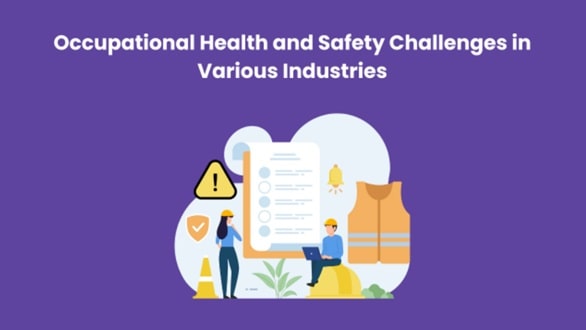Occupational health and safety is an ever-evolving job sector, as industries continuously adapt to new technologies, processes, and regulations. Ensuring the safety and well-being of workers is paramount, but each industry comes with its unique set of challenges. In this extensive exploration of occupational health and safety, we will examine the specific challenges faced by various industries. Additionally, we will introduce the concept of IOSH Certification and answer the question, What is IOSH?

Table of contents
- Understanding Occupational Health and Safety
- Challenges in Occupational Health and Safety
- Construction Industry
- Healthcare Industry
- Manufacturing Industry
- Agriculture Industry
- Oil and Gas Industry
- Hospitality Industry
- What is IOSH Certification?
- Key IOSH Certifications
- Benefits of IOSH Certification
- Conclusion
Understanding Occupational Health and Safety
Understanding the principles of occupational health and safety is essential before exploring the difficulties encountered by various businesses. The goal of occupational health and safety, sometimes known as HSE (Health, Safety, and Environment), is to protect workers’ health while they are at work. This entails spotting and removing possible risks, following safety guidelines, and encouraging a safety-conscious culture.
Challenges in Occupational Health and Safety
The hazards related to occupational health and safety might differ greatly amongst industries. These difficulties are contingent upon the kind of job being done, the particular hazards involved, and the industry laws. These are a few issues unique to the industry:
Construction Industry
Because of the heavy equipment, heights, and electrical work involved, construction sites are dangerous by nature. Common worries include falls, electrocutions, and equipment mishaps. In the construction sector, adhering to safety rules may provide challenges. In the US, adherence to regulations such as those set out by the Occupational Safety and Health Administration (OSHA) is crucial. A wide variety of personnel, many with varying degrees of experience or language barriers, are often employed on construction sites. It might be difficult to provide consistent instruction and communication.
Healthcare Industry
Patients and visitors pose a danger of violence against healthcare professionals, such as nurses and physicians. It’s critical to manage security and provide de-escalation training. There is always a worry about the possibility of contracting infectious illnesses, particularly in hospital environments. Sufficient personal protective equipment (PPE) and strategies to control infection are necessary. Patient handling puts healthcare personnel at risk for musculoskeletal injuries. In order to stop these injuries, the right tools and training are crucial.
Manufacturing Industry
Automation and large equipment are used in the industrial sector. It is vital to protect workers’ safety while they are around machinery and robots. Hazardous chemicals may be present for employees in production facilities. It’s crucial to handle, store, and utilise PPE properly. Working in the industrial industry often exposes workers to loud noise levels and repeated jobs, which may cause musculoskeletal injuries and hearing damage.
Agriculture Industry
Farmworkers use large machinery and equipment, which increases the possibility of mishaps and injuries, particularly for individuals with little or no training. There may be dangers associated with the use of pesticides in agriculture. Safety measures and training are required. Extreme weather is one of the many environmental elements that farmworkers are subjected to, and it may have an impact on their health and safety.
Oil and Gas Industry
There is a significant danger of fires and explosions in the oil and gas sector due to the presence of explosives and flammable materials. A lot of oil and gas activities are situated in isolated regions, which makes it difficult for accident victims to get emergency medical assistance. Workers often work in cramped areas, which increases their risk of entrapment and respiratory problems.
Hospitality Industry
Because there are liquids and different surfaces in the hospitality sector, there is a considerable danger of slip and fall occurrences. Hotel and restaurant employees run the danger of injury while handling cleaning chemicals. Appropriate instruction and tools are necessary. Because they spend a lot of time on their feet, employees in the hospitality industry may have ergonomic issues.
These are just a few instances of the many difficulties that come with occupational health and safety in many sectors. Although these problems may have industry-specific characteristics, some general guidelines and procedures may reduce risks and advance a safety-conscious culture. The acquisition of an IOSH certification is one such procedure.
What is IOSH Certification?
The Institution of Occupational Safety and Health, or IOSH, is a professional organisation with international recognition that works to advance workplace health and safety. In order to provide professionals with the information and abilities they need to successfully manage health and safety, IOSH offers a variety of approved courses and certifications.
People who work in a variety of sectors, including manufacturing, healthcare, and construction, often obtain IOSH credentials. Professionals may help create a safer workplace by using the thorough grasp of occupational health and safety concepts and best practices that these credentials provide.
Key IOSH Certifications
Managers, supervisors, and anybody else responsible for overseeing health and safety at work might benefit from earning the IOSH Managing Safely credential. It addresses important subjects, including event investigation, risk assessment, and hazard identification. Designed for workers at every level, this certification offers a basic understanding of health and safety. It presents important ideas and promotes a culture of safety in the workplace.
Senior executives and leaders are the target audience for the IOSH Leading Safely qualification. It emphasises the tactical aspects of health and safety, highlighting the role that leadership plays in establishing a secure workplace. Board members and senior executives are the target audience for the IOSH Safety for Executives and Directors programme, which emphasises the moral, financial, and legal obligations related to health and safety.
Benefits of IOSH Certification
Professionals holding IOSH certificates are equipped with a comprehensive understanding of health and safety best practices, which allows them to make well-informed suggestions and judgements. An IOSH certification shows expertise and a dedication to safety, which may lead to job progression in a variety of sectors.
Professionals operating in many areas and sectors find value in IOSH qualifications as they are widely accepted across the world. Certified professionals are better able to recognise and reduce hazards, which helps to create a safer atmosphere for both themselves and their coworkers.
Conclusion
All industries have inherent issues related to occupational health and safety, but the kind and severity of these challenges might differ greatly. To tackle these obstacles, a trifecta of regulatory observance, training tailored to the needs of the business, and the development of a safety-conscious culture is needed. IOSH certificates, such as the IOSH Managing Safely programme, provide professionals with a strong basis on which to comprehend these issues and find solutions. People in a variety of sectors may further their careers and promote the safety and well-being of their coworkers by earning an IOSH certification. The need for qualified health and safety workers won’t go away, and IOSH certification will always be valuable as a mark of competence and dedication to worker safety.

